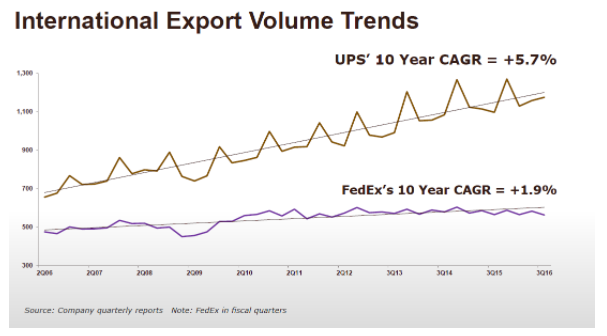Being a member of an oligopoly is good. It’s even better when you’re the biggest firm in that oligopoly. And when it comes to global logistics and shipping, United Parcel Service (UPS ) takes the cake as the world’s largest. Its dominant position has afforded the firm years’ worth of steady profit growth and dividends.
While headwinds have recently made themselves known, UPS has the ability to navigate these challenges with relative ease. Moreover, UPS has also found new avenues for growth.
For investors looking for a great addition to their dividend portfolio, UPS offers plenty of opportunity for income and growth potential. This is one stock they should ship directly into their holdings.
UPS is rated very high using our DARS model. Get the complete breakdown here.
UPS’ Long History of Profits and Dividends
There’s nothing particularly exciting about delivering packages. In fact, it’s downright boring. But UPS has managed to turn boring into a multi-billion profit-making machine. There are only a handful of global delivery firms and none has the reach of UPS. Not even chief rival FedEx (FDX ). Today, UPS ships more than 15 million packages per day in more than 220 countries and territories around the world.
That dominance stems from the company’s broad and almost irreplaceable moat.
Since its founding in 1907, UPS has built a global infrastructure network of distribution centers, trucks, airplanes and couriers. Such a vast network isn’t made overnight. As a result, it faces practically no competition in its respective operating markets. More importantly, its size and scale allow it to realize lower costs and higher margins than smaller delivery services.
Find out a complete history of the original Dow Dozen.
All of this has translated into steady profit growth over the last few decades as UPS built this network and became the go-to name in shipping. Over the last five years, UPS has managed to grow its revenues at a compound annual growth rate (CAGR) of just over 3%. While that may not seem significant, it’s still impressive for a firm doing about $61 billion in sales per year.
And with such a steady sales growth, UPS has been a steady dividend grower as well. The firm has paid a regular dividend for the last 47 years, and over the past ten years, it’s really ramped up its efforts to increase that payout. In the last decade, UPS grew its dividend by 97%.
Get the complete dividend history of UPS here.
How Brown Plans to Grow
Part of that continued revenue growth is that UPS continues to see rising package volumes across its system. The firm has been a major winner in the growth of e-commerce and online retail sales. As consumers click to buy goods, UPS is increasingly the primary delivery option for retailers. That’s good news as online sales have now approached close to $400 billion and command more than 10% of the total retail pie. With estimations of online sales continuing to rise, UPS – with its various business-to-consumer options – will continue to see higher volumes across its system.
Increasingly as well, Brown’s major investments overseas continue to work wonders. Export and international shipping continue to drive revenue gains. As you can see by the chart below, UPS’ export volumes have compounded much faster than rival FedEx’s. Today, international shipments now represent 28% of UPS’ operating profit, up from just 6% in 2000. Again, the reason remains UPS’ massive logistics system.

So, UPS continues to deliver more packages thanks to rising international and e-commerce-based transactions, but it’s also getting better margins for those delivered packages than its rivals. That’s because Brown has started to use a plethora of tech in its operations. The firm has spent billions in facility automation, artificial intelligence software, network planning tools and different pricing methods to squeeze out higher margins from growing e-commerce deliveries. This is helping to turn back the tide of margin compression due to the variability in products purchased online. Large items that weigh nothing can wreck pricing models for shippers, while oversized items can screw up delivery guarantees.
Brown has also been quite successful at “bolt-on” acquisitions over the years, and its latest moves are a testament to that fact. Last November, UPS purchased privately held Marken. Marken ships roughly 50,000 medicines and biological samples around the globe each month. This helps flesh out its own healthcare logistics operations including facilities to ship/store medical devices and drugs. With healthcare logistics spending estimated to hit $16.7 billion by 2020, UPS is cementing itself as the leader in the space.
Find out why portfolio size is an important factor in investing.
Some Speed Bumps for UPS
Now, it isn’t all sunshine and lollipops for UPS. There are a few headwinds. Namely, Amazon’s (AMZN) desire to potentially ship packages itself. However, the scale and investment required to do so maybe more than Bezos & Company is bargaining for. Remember, Amazon’s mission is different than UPS’ or FDX’s. It wants its customers to be happy, which might mean delivering less-than-profitable packages. Whereas, the shippers are looking to make money from moving boxes.
Finally, decelerating global growth and protectionism measures from the Trump administration could put a collar on recent export growth at UPS. Trade has remained a central talking point from Trump and his cabinet.
The Bottom Line
Operating a market leading position in a very hard to penetrate industry has worked well for UPS and its shareholders. Revenues, package volumes and margins all continue to rise, while new growth avenues will continue to pay these benefits. The benefits for shareholders include higher and higher dividends and capital appreciation. With a P/E of just 20 and a 3.1% yield, UPS is an ideal stock for dividend investors to buy today for a year’s worth of potential.
With seven consecutive years of dividend increases, UPS is close to entering the ten-year dividend increase list. Find all the stocks that have increased their dividends for more than ten years here.





